As one of the largest ever winter storms rolled out of New York City in late January, Albert Weaver’s surf expedition went something like this. Dig car out: one hour. Car battery is dead. Charge it: one hour. Plow truck buries car. Dig it out again: one hour. Drive to Rockaway, New York City’s only surf beach: one hour.
For Weaver, an entire morning doing battle with the city instantly became worth it when he made it to the sand. The storm had given him the gift of near perfect barreling waves. The larger sets coming in were overhead, at about seven feet.
“Anytime there are waves, regardless of how cold it is, you have to go out,” said Weaver, a 47-year-old artist who lives in Bushwick.
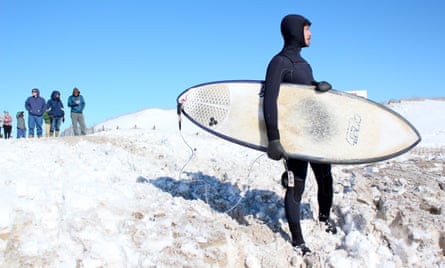
New York City’s surfing community is knit together through adversity. The conditions will probably be small and choppy, except after a hurricane or snowstorm. A high-pressure career often gets in the way of the time-intensive journey to the beach. The silver lining is the city has developed a culture distinct from cliche surf hubs. It’s gritty and diverse with an eye for style.
“I would say if you can surf here you can surf anywhere,” said Grace Lee, 32 and a vice-president at a civil engineering firm in downtown Manhattan. “It is like running with weights on.”
Like other transplants, Lee thought moving to New York meant nailing the coffin shut on surfing. That changed when she stumbled across a Meetup group of surfers who lived in the city. She is now in the water two or three times a week, year round.
“You could be in your wetsuit early mornings and then you jump on the train and be in your business suit at work by 9.30,” Lee said.
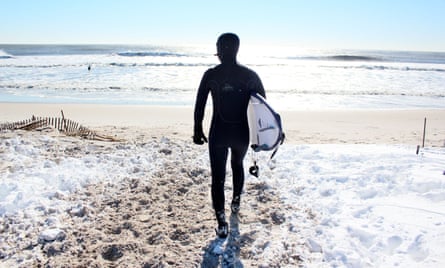
Focused and diverse
The same tools one might use for career climbing in New York are the same for making it out to the water, especially in the winter. There’s detailed tracking of tides, swell height and wind direction. Subway track work needs to be negotiated. If you leave one wetsuit bootie at home, forget going in the water, which can dip to 33 degrees in winter.
“The surfers I’ve met here are focused,” said Nicky Keros, a film student who documents the city’s surfing community. “They have an agenda, they know what they are going to do today, they know how to do it, how to prepare and execute.”
Keros is a surfer from warmer waters. He said he isn’t ready to invest in the equipment and deal with the discomfort of jumping in the surf.
To lessen the burden of city surfing, Sangik Tsedenov rents two houses. One is in Queens, where he lives. The other is in Rockaway, which he shares with five other surfers. That house is for storing boards, hot showers and sleeping over before an early surf session.
“It is a lot of commitment,” said Tsedenov, 30 and an IT guy. He’s also Russian.
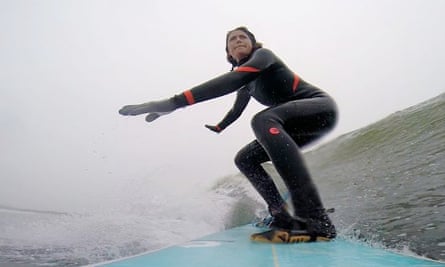
That’s one of the things that struck Weaver as unique to surfing in New York City. He was accustomed to the typical blond-haired and blue-eyed surfers in California, his home state. Here in the water there are Japanese, French, Australian, Taiwanese, and the list goes on.
“You have different languages spoken in the water and I think that’s incredible,” said Weaver.
The age of surfers also tends to run older, according to Chris Gentile, from Pilgrim Surf + Supply store in Williamsburg.
“They come to surfing much later in their life in their 30s, 40s, 50s,” he said, adding that surfing’s egalitarian nature is intensified in New York City.
“The social makeup in the lineup [of surfers] at Rockaway can be billionaires, firemen, carpenters, artists,” Gentile said.

Recent revival
To be clear, there has always been a surf community in the city, although the strength of its heartbeat fluctuates. While researching for his documentary about New York City firefighter and surfer Don Eichin, film-maker Thomas Brookins found an image from the late 1800s. It showed a man and child at Rockaway Beach standing next to a giant metal surfboard reminiscent of an airplane wing.
“The construction of that board really says something about New York’s surfing culture – it has definitely been there for quite some time,” said Brookins.
That culture is at a time of resurgence. At Rockaway, New York City’s only surf beach (although the winter storm produced a break at Coney Island, a once in a decade phenomenon), crime is down about 70% since 1990. Trendy bars and restaurants are now common rather than unusual.
The exponential improvement in wetsuits – flexible rubber and secure seams – has also made surfing year round somewhat comfortable, according to Mikey DeTemple, New York City’s only professional surfer (yes, it has one).
“You’re equally as warm walking down Broadway in 20 degrees and a 30 mile per hour wind,” he said, “as you are in lineup at some of the raw spots in New York with the same wind and temperature.”
Even though surfing has defined much of DeTemple’s life, basing himself in New York City – he grew up on Long Island – also allows him to do other things. You might have seen him in Jack Spade’s 2014 menswear campaign. DeTemple also directs surf films and advertising campaigns.
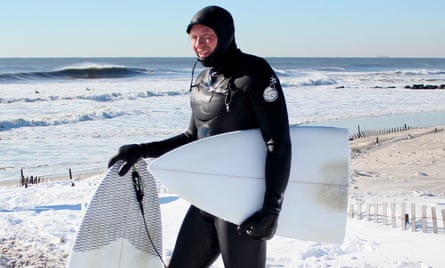
It’s this balance in identity, along with New York’s eye for good design and fashion, that has shaped the city’s boutique surf brands. They are thriving at home and overseas.
Gentile from Pilgrim described his brand as surf wear for adults. Instead of neon colors and loud logos, the design is minimalist with a focus on sustainability and quality.
“We were making clothes for people who are surfers, but it doesn’t have to say it on our sleeves,” said Gentile.
Saturdays NYC, another boutique brand, has four locations in Japan. It recently opened an outpost in Australia, the birthplace of big brands like Billabong, Rip Curl and Quiksilver.
“[Saturdays] is our interpretation of surfing and surf culture blending with the influence of New York style and fashion,” said Morgan Collett, a Saturdays co-founder. He missed the swell from the storm only because he was presenting the brand’s next collection in Paris.
“It was probably the best day I’ve seen on the east coast in 10 years,” Collett said.
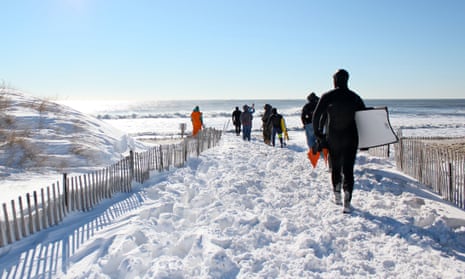
Comments (…)
Sign in or create your Guardian account to join the discussion